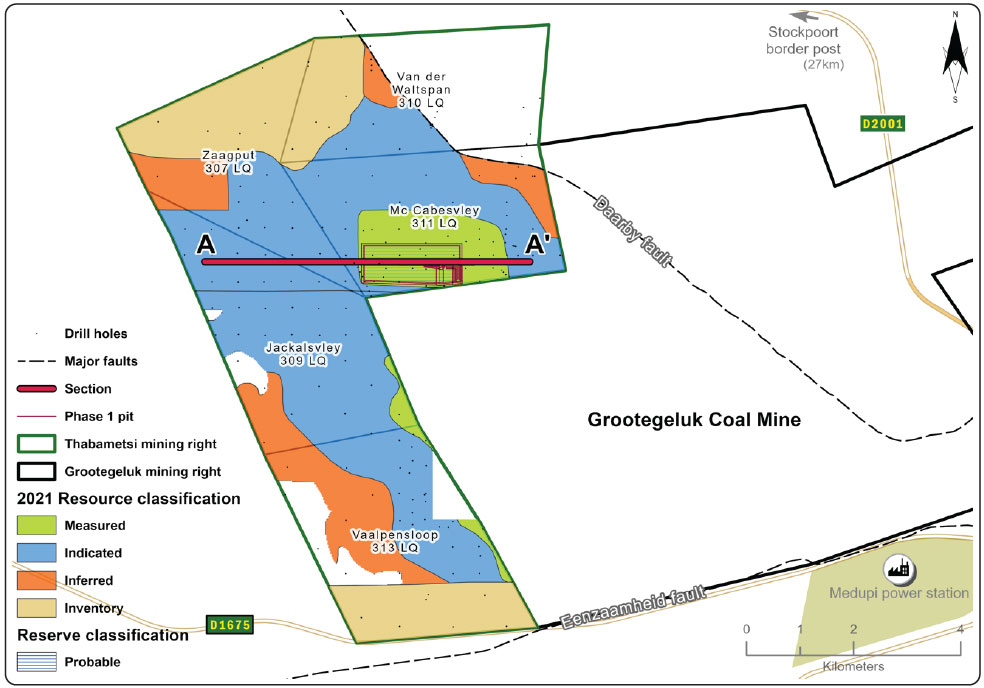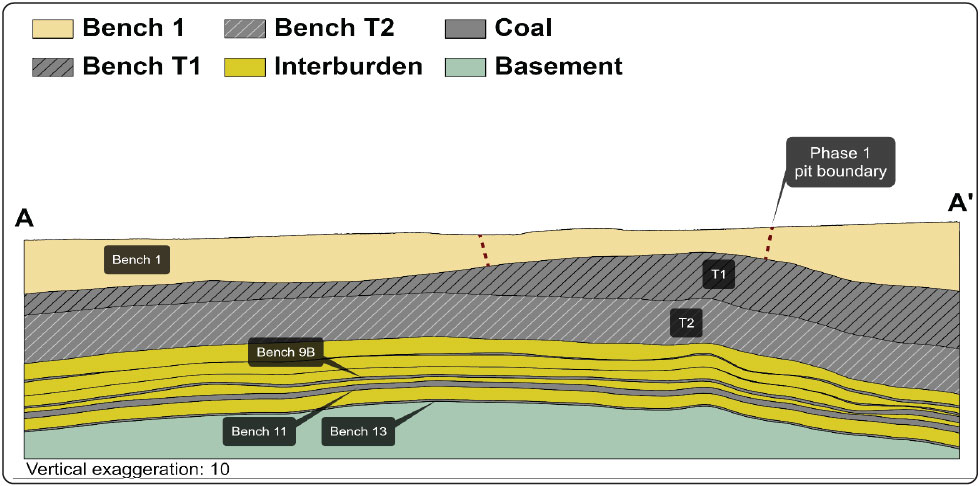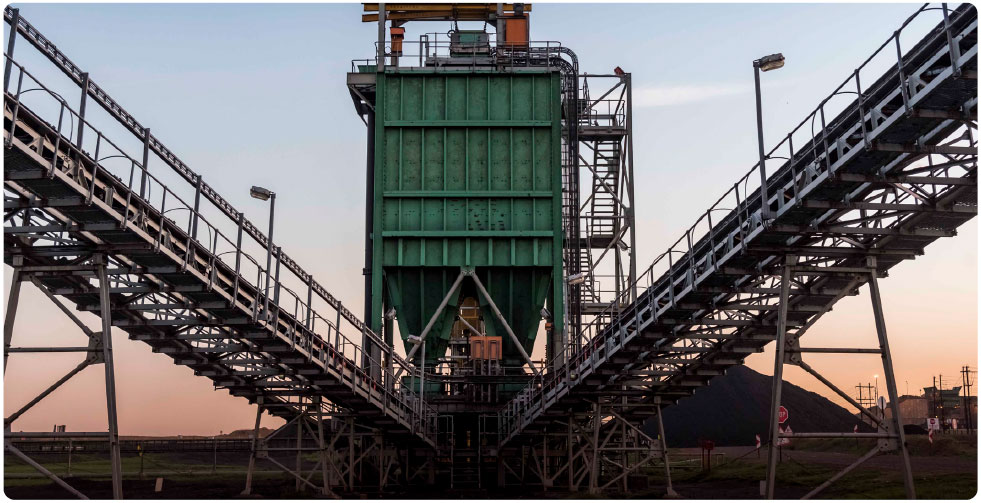Currently viewing: Thabametsi | Next: Exploration expenditure
Thabametsi is divided into two portions, a northern open cast portion and a southern underground portion. The Northern open cast portion aims to produce power station coal for an on-site IPP while the Southern underground portion is earmarked for beneficiated high value products. The strategic partner identified to undertake the development of the IPP has since withdrawn from the project and Exxaro is evaluating various options on the development of this Resource.
Table 46: Thabametsi overview
| TOPIC | INFORMATION | ||||
| Location | 22km west of the town of Lephalale in Limpopo, South Africa | ||||
| History | Previous ownership | Material notes | |||
| 1976 to 1988 | Iscor – Iscor mining | Exploration drilling | |||
| 1989 to 2006 | Kumba | Exploration drilling | |||
| 2007 to 2015 | Exxaro Resources | Prospecting right and exploration activities specifically on the project area | |||
| 2016 to current | Exxaro Resources | Mining right registered in 2016, valid till 2046 | |||
| Adjacent properties | Grootegeluk Mine to the east | ||||
| Infrastructure | Thabametsi is adjacent to Grootegeluk and therefore will use the same infrastructure. It can be reached from Lephalale via the hard-topped Nelson Mandela Drive, which is linked to the R510 road connecting Lephalale to the town of Vaalwater to the south and the Stockpoort border post between South Africa and Botswana to the north. Power supply to Grootegeluk is obtained directly from the power station via two 132kV lines . Raw water is delivered to the mine and to a water-treatment plant on the farm Zeeland by the 700mm-diameter Hans Strijdom pipeline. The pipeline originates at the Mokolo Dam, in the Waterberg mountain. | ||||
| Coalfield | Waterberg coalfield | ||||
| Main seams | The upper part of the coal deposit, the Volksrust Formation (approximately 60m thick) is classified as a thick interbedded seam deposit type, comprising intercalated mudstone or carbonaceous shale and bright coal layers. The Vryheid Formation (approximately 55m thick) forms the lower part of the coal deposit and comprises carbonaceous shale and sandstone with interbedded dull coal seams varying in thickness from 1.5m to 9m. It is therefore classified as a multiple-seam deposit type. | ||||
| Seam development | The geology is similar to Grootegeluk's geology but practical mining practice required a different bench configuration. In the north, the full succession of the Volksrust and Vryheid formations is present. However, further south, the Volksrust Formation thins out and eventually disappears. A pertinent channel sandstone in the northern portion of the project area affects benches 9A and 9B. | ||||
| Depositional control | The Zoetfontein fault forms the boundary of the Waterberg coalfield in the north while the Eenzaamheid fault forms the boundary in the south. The Daarby fault, with a throw of some 350m, divides the coalfield into a deep north-eastern portion and a shallow south-western portion. The first fresh coal in the shallow south-western portion is on average 20m below surface. The lowermost coal seam (Zone 1) occurs at a depth of about 130m in the shallow portion of the coalfield but this may vary depending on the local structure. The predominantly horizontal coal-bearing formations have a very gentle dip to the south-east near Grootegeluk. Only a few dolerite dykes outcrop in the south-eastern portion of the Waterberg coalfield and no sills have been encountered in any exploration drill holes drilled in the mine right area to date. | ||||
| Resources and Reserves | The Resource extent is restricted by the depositional controls discussed above. The Reserves are restricted within the Resource blocks. | ||||
| Mining method | The project area is divided into a northern opencast portion and a southern underground area. | ||||
| Beneficiation | N/A | ||||
| Product | The northern portion aims to produce power station coal for an on-site IPP as part of phase 1. | ||||
| Market | Local | ||||
| Mining right | Thabametsi has an approved mining right that covers some 5 455ha. | ||||
| Environmental approvals | All environmental appeals have been favourably addressed for the declared Reserves. | ||||
| Projects/Feasibility studies |
A feasibility study on phase 1 was successfully concluded in 2016 and studies on extending the phase and the southern project area are ongoing. In October 2016, the South African Minister of Mineral Resources and Energy announced that the Thabametsi power project, for which Thabametsi project has a 30-year CSA, had been selected as a preferred bidder in the first bid window of South Africa's coal-baseload IPP procurement programme. The subsequent process to realise this initiative has progressed during the last number of years. The project development agreement with our IPP project partner, however, lapsed during the previous reporting year and we subsequently changed our reporting of Proved Reserves to Probable category to address this uncertainty. Exxaro is currently ensuring that all compliance actions are executed. | ||||
Figure 15: Thabametsi project

Figure 16: Thabametsi cross-section

Table 47: Resource estimation methodology and reporting
| PROCESS | INFORMATION | ||
| Drilling, logging and sampling | Logging and sampling follow the same protocols as at Grootegeluk mine. | ||
| Laboratory and accreditation | Bureau Veritas, SANAS T0469. | ||
| Laboratory dispatch and receiving process | Sampling of drill holes is only conducted after the stratigraphy has been correlated. The geologist in charge supervises all drill hole drilling and is responsible for logging and sampling. Each sample submitted to the laboratory is accompanied by a unique sample number for validation and tracking, as well as a submission list that serves as a sample advice sheet with instructions for analysis. | ||
| Laboratory quality control and quality assurance | The laboratory follows one of four standard suites of analysis for each sample from Grootegeluk, namely Volksrust Formation coal, Volksrust Formation shale, Vryheid Formation coal and Vryheid Formation shale. Emphasis is placed on ensuring data integrity though rigorous procedures and supervision while processing. As part of the assurance and control process, audits are performed internally and externally. Bureau Veritas is accredited for analytical work and participates in monthly local and international round robins. | ||
| Data datum | WGS84 – LO27 | ||
| Drill hole database | acQuire | ||
| Number of drill holes in MR | 218 | ||
| Number of drill holes used for Resource estimation | 116 | ||
| Number of drill holes used for classification | 116 | ||
| Data compositing and weighting | Coal analysis and beneficiation (CAB) module in Sable Data Warehouse | ||
| Data validation | Conducted using queries in acQuire and Excel | ||
| Geological modelling software | Geovia MinexTM | ||
| Estimation technique | Growth algorithm | ||
| Previous model date | 2014 | ||
| Last model update | 2015 | ||
| Grid mesh size | 45m x 45m | ||
| Scan distance | 1 000m | ||
| Data boundary | 300m | ||
| Model build limits | Upper: limit of weathering and topography/collar Lower: Zone 1 floor | ||
| Model outputs | Roof, floor and thickness grids generated for structure Raw and wash quality grids | ||
| Changes to modelling process | None | ||
| Thickness cut-off and extraction height considerations | Opencast =0.5m | ||
| Quality cut-offs (adb) | Ash =65% | ||
| Geological loss applied | Variable per bench based on the adjacent Grootegeluk methodology | ||
Table 48: Resource classification criteria
| CATEGORY | TYPE OF DRILL HOLES | DRILL HOLE SPACING | STRUCTURALLY COMPLEX AREAS | DRILL HOLES/HA | ||||||||
| Measured | Cored drill holes with applicable coal qualities | 0m to 350m | (Matrix) Additional geophysically logged drill holes needed | 0.08 | ||||||||
| Indicated | Cored drill holes with applicable coal qualities | 350m to 500m | (Matrix) Additional geophysically logged drill holes needed | 0.04 | ||||||||
| Inferred | Cored drill holes with applicable coal qualities | 500m to 1 000m | (Matrix) Additional geophysically logged drill holes needed | 0.01 | ||||||||
Table 49: RPEEE considerations
| ITEM | CRITERIA | CRITERIA MET | COMMENT | ||||||
| Geological data | Data has been validated and signed off by Competent Person | Yes | Geological structures, seam thickness ≤0.5m, ash content ≥65%. Coal qualities reported on an air-dried basis | ||||||
| Geological model | Geological model has been considered and signed off | Yes | 2015 | ||||||
| Structural model | Structural model was considered and signed off | Yes | 2015 | ||||||
| Mining | Mining assumptions considered and defined | Yes | Opencast and underground | ||||||
| Assurance | Exxaro internal audits and external audit conducted | Yes | 2015 | ||||||
| Economic evaluation | Exploitation study with economic and mining assumptions, including geotechnical and geohydrological assumptions | Yes | Studies that underpin the IPP study and mining right mine works programme | ||||||
| Environmental | Reasonable demonstration that environmental approvals can be obtained within the context of local, regional and national governmental legislation | Yes | All environmental approvals and land ownership in place | ||||||
| Tenure | Formal tenure must be demonstrated with reasonable demonstration that a mining right approval can be obtained within the context of local, regional and national governmental legislation | Yes | Mining right, expires in 2046 with no impediments noted. | ||||||
| Infrastructure | Assumptions used should be reasonable and within known/assumed tolerances or have examples of precedence | Yes | Current infrastructure | ||||||
| Market | A potential market for the product with a reasonable assumption that this market is sustainable | Yes | IPP and current Grootegeluk steam coal market | ||||||
Table 50: Reserve estimation
| TOPIC | INFORMATION | ||
| Software | XPAC | ||
| Reserving process | For the phase 1 of the IPP feasibility study, XPAC mine-scheduling software is used to derive remaining saleable Reserves from RoM Reserves in the approved pit layout. After converting the geological model’s grids to the appropriate format, the floor, roof and thickness data as well as the quality data for each bench is imported into the XPAC model. With this model, validations are performed to evaluate the data for possible mistakes, such as incremental yields for each bench rising with increases in relative float densities. | ||
| Conversion classification | Indicated Resources are generally converted to Probable Reserves and Measured Resources to Proved Reserves after consideration of all applicable modifying factors. If one or more of the modifying factors have not been fulfilled, Measured Resource is either not converted or the Measured Resource is converted but downgraded to Probable and the associated risk is clearly stated. Inferred Resources are not converted to Coal Reserves. The Coal Reserve is based on a bankable feasibility project level of investigation. The project development agreement with our IPP project partner lapsed during the previous reporting year and we subsequently changed our reporting of Proved Reserves to the Probable category to address this uncertainty. Exxaro is currently ensuring that all compliance actions are executed. |
||
| Inferred Resources inside LoM | N/A | ||
Modifying factors
| Average thickness cut-off | ≤1m | ||
| Quality cut-offs | Raw CV ≤11Mj/kg | ||
| Mining loss | *T1 — 0.5m losses to overburden *T2 — 0.25% of coal left in pit bottom |
||
| Boundary pillar | N/A | ||
| Dilution | Applied to in situ mineable Reserves due to inter-layered composition of deposit | ||
| Contamination | T2 — 0.3m | ||
| Mining recovery efficiency | No additional losses due to proposed mining method. Coal transfer between benches T1 and T2 will balance out over time as both go to same plant | ||
| Planned average slope angles | 35 degrees | ||
| Practical plant yield | Crushing and screening process 98% | ||
| Strip ratio cut-off | Energy strip ratio >7Gj/ex-pit tonnes Strip ratio <0.3m3/t |
||
| Environmentally sensitive areas | No sensitive areas in pit layout | ||
| Legal | The layout is within the mining right boundary | ||
| Social | There are no known socially sensitive areas in the pit layout (for example, graveyards and dwellings) | ||
| Geohydrological | No areas identified in the mining area | ||
* T1 and T2 mining benches (Figure 16).
Table 51: Thabametsi Coal Resource and Coal Reserve statement
| Category | 2021 (Mt) |
2020 (Mt) |
Difference in tonnes (Mt) |
Difference (%) |
Reason for change |
| Measured | 270 | 270 | |||
|---|---|---|---|---|---|
| Indicated | 749 | 749 | |||
| Inferred | 2 857 | 2 857 | |||
| Total Coal Resources | 3 876 | 3 876 | No change | ||
| Proved | |||||
| Probable | 130 | 130 | |||
| Total Coal Reserves | 130 | 130 |
Summary of the exploration for the reporting year can be seen in Table 52. For detailed expenditure, please refer to Table Table 54.
Table 52: Exploration summary
| OBJECTIVES | PROGRESS IN REPORTING YEAR | PLANS FOR NEXT REPORTING YEAR | ||||
| Reviewing of future exploitation options for full mining right area | Various options concluded | Evaluation of options for the best exploitation strategy. | ||||
Table 53: Thabametsi risks
| RISK | DESCRIPTION | MITIGATION | ||||
| Market | The project development agreement with our IPP project partner lapsed. | Exxaro is investigating various future options for the development of the project, communicated to the DMRE, including alternative markets such as the Grootegeluk steam coal market. | ||||
Currently not an operating mine.

Silo at ECC
 Report Index
Report Index Integrated Report 2021
Integrated Report 2021
